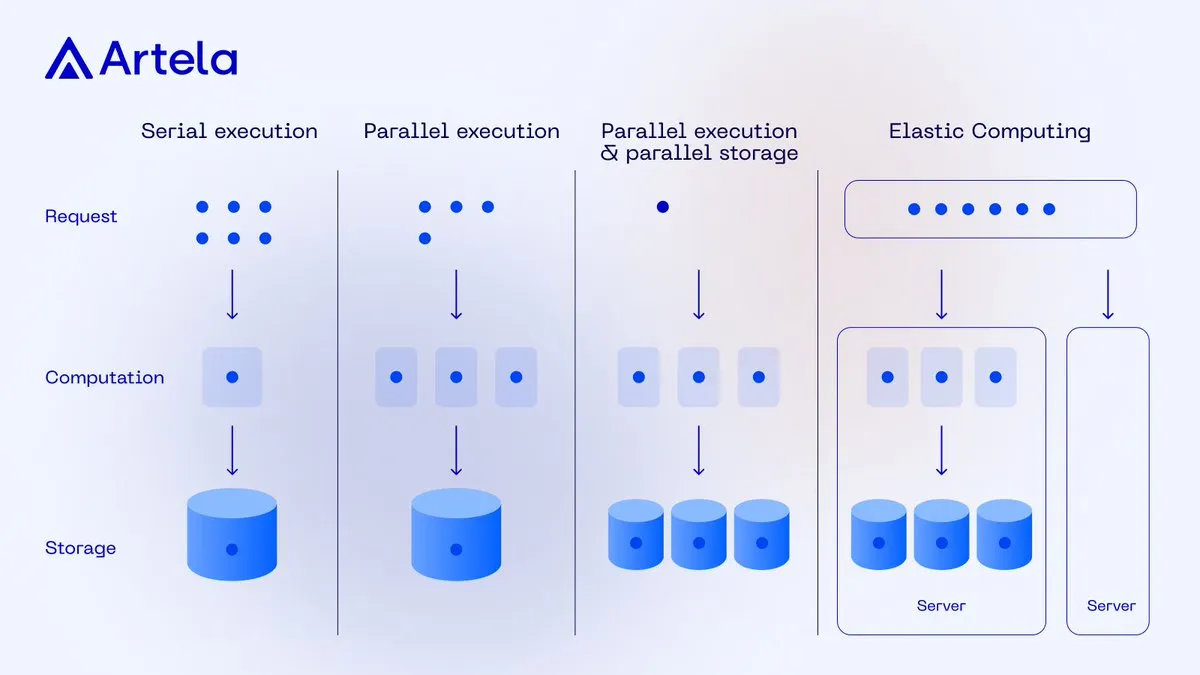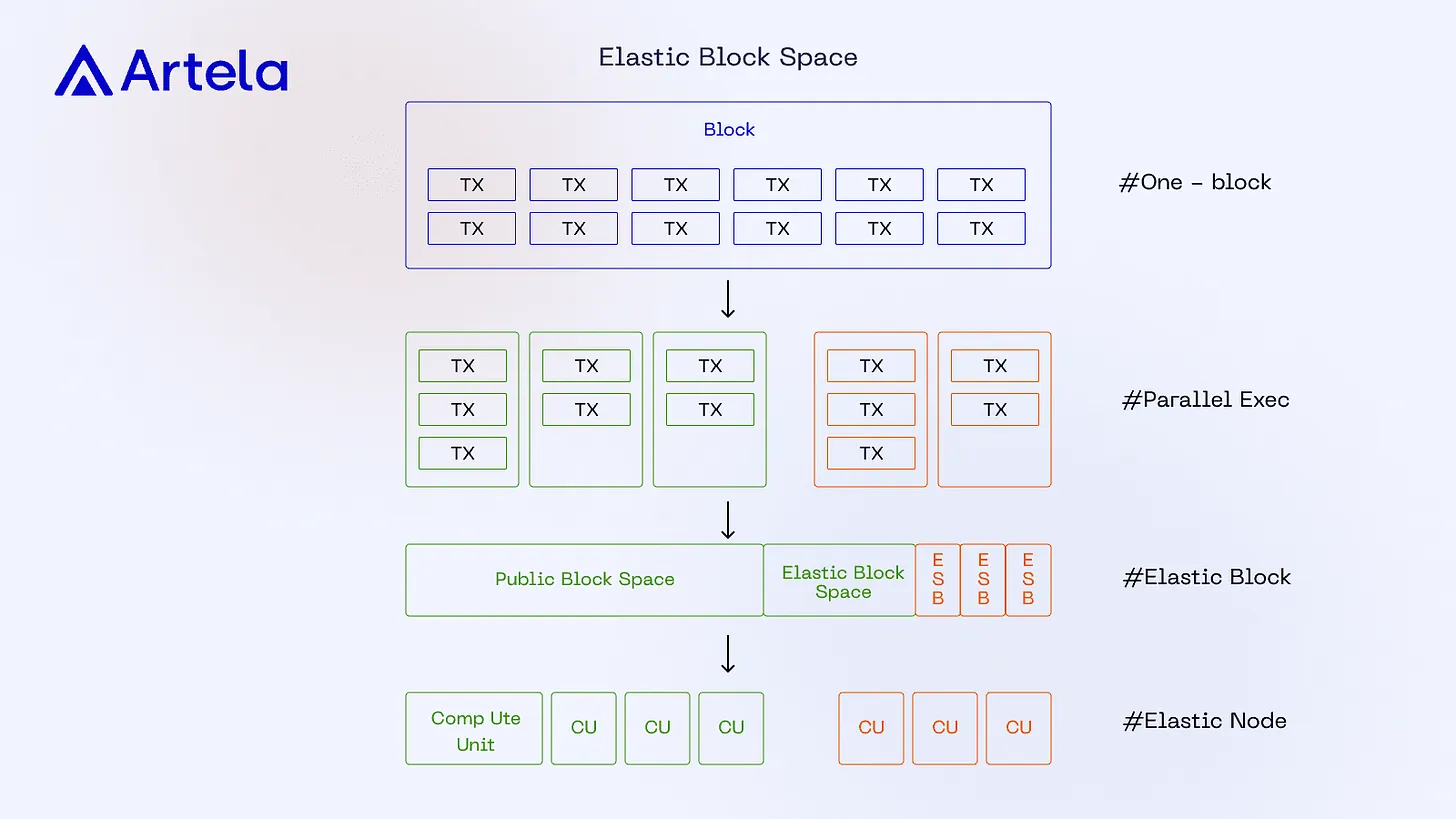In March of this year, the scalability L1 blockchain network Artela launched EVM++, an upgrade to the next-generation EVM execution layer technology. The first "+" in EVM++ represents "Extensibility," achieved through Aspect technology to support developers in creating on-chain custom programs in a WebAssembly (WASM) environment. These programs can collaborate with EVM to provide high-performance, application-specific extensions for dApps. The second "+" represents "Scalability," achieved through parallel execution technology and the design of elastic block space to significantly enhance network processing capacity and efficiency.
WebAssembly (WASM) is an efficient binary code format capable of achieving near-native execution speeds in web browsers, particularly suitable for handling computationally intensive tasks such as AI and big data processing.
Yesterday, Artela released a whitepaper detailing how it enhances blockchain scalability by developing parallel execution stacks and introducing elastic block space based on elastic computing.
The Importance of Parallel Processing
In the traditional Ethereum Virtual Machine (EVM), all smart contract operations and state transitions must remain consistent across the entire network. This requires all nodes to execute the same transactions in the same order, even if some transactions have no actual dependencies between them. This results in unnecessary waiting and inefficiency.
Parallel processing allows multiple processors or computing cores to simultaneously execute multiple computing tasks or process data, significantly improving processing efficiency and reducing runtime, especially for complex or large-scale computing problems that can be decomposed into independent tasks. Parallel EVM is an extension or improvement of the traditional Ethereum Virtual Machine, capable of simultaneously executing multiple smart contracts or contract function calls, significantly improving the throughput and efficiency of the entire network. Additionally, it can optimize efficiency in single-threaded execution. The most direct advantage of parallel EVM is enabling existing decentralized applications to achieve internet-level performance.
Artela Network and EVM++
Artela is an L1 that enhances the extensibility and performance of EVM by introducing EVM++. EVM++ is an upgrade to EVM execution layer technology, integrating the flexibility of EVM and the high-performance features of WASM. This enhanced virtual machine supports parallel processing and efficient storage, enabling more complex and performance-demanding applications to run on Artela. EVM++ not only supports traditional smart contracts but also allows high-performance modules to be dynamically added and run on-chain, such as AI agents. These agents can run independently as on-chain coprocessors or directly participate in on-chain games, creating truly programmable NPCs.
Artela ensures the computational capacity of network nodes can flexibly expand based on demand through parallel execution design. Additionally, validator nodes support horizontal scaling, allowing the network to automatically adjust the scale of computing nodes based on current load or demand. This scaling process is coordinated by an elastic protocol to ensure sufficient computing resources in the consensus network. Elastic computing ensures the scalability of network node computing power, ultimately achieving elastic block space, allowing large dApps to request independent block space based on specific needs. This not only meets the need for expanding public block space but also ensures the performance and stability of large applications.

Detailed Explanation of Artela's Parallel Execution Architecture
1. Predictive Optimistic Execution
Predictive optimistic execution is one of Artela's core technologies and a distinguishing feature from other parallel EVMs such as Sei and Monad. Optimistic execution refers to a parallel execution strategy that assumes no conflicts between transactions at the initial state. In this mechanism, each transaction maintains a private state version, recording modifications without immediate finalization. After transaction execution, a validation phase checks for conflicts caused by global state changes from other parallel transactions during the same period. Upon detecting conflicts, transactions are re-executed. Predictive refers to analyzing historical transaction data through specific AI models to predict dependencies between transactions about to be executed, grouping transactions and arranging their execution order based on which transactions may access the same data. This reduces execution conflicts and redundant execution. In contrast, Sei relies on developers defining transaction dependencies in advance, while Monad uses compiler-level static analysis to generate transaction dependency files, lacking EVM equivalence and Artela's adaptive capability based on AI dynamic prediction models.
2. Async Preloading Technology
Async preloading technology aims to address input/output (I/O) bottlenecks caused by state access, with the goal of improving data access speed and reducing transaction execution waiting time. Before transaction execution, Artela preloads the required state data from slow storage (e.g., hard disk) to fast storage (e.g., memory) based on predictive models. By preloading necessary data, it reduces I/O waiting time during execution. When data is preloaded and cached, multiple processors or execution threads can access this data simultaneously, further increasing parallelism in execution.
3. Parallel Storage
With the introduction of parallel execution technology, transaction processing can be parallelized, but if data read/write and update speeds do not increase synchronously, it becomes a critical factor limiting overall system performance, shifting the bottleneck to the storage level. Solutions like MonadDB and SeiDB have begun focusing on optimizing the storage level. Artela has developed parallel storage by drawing from and integrating various mature traditional data processing technologies, further enhancing the efficiency of parallel processing.
The parallel storage system is designed to address two main issues: achieving parallel processing of storage and improving the efficient recording of data states in the database. Common issues in data storage processes include data expansion during writing and increased pressure on database processing. To effectively address these issues, Artela has adopted a strategy of separating State Commitment (SC) and State Storage (SS). This strategy divides storage tasks into two parts: one part is responsible for fast processing operations without retaining complex data structures to save space and reduce data duplication, while the other part is responsible for recording all detailed data information. Additionally, to avoid affecting performance when processing large amounts of data, Artela adopts a method of merging small blocks of data into larger blocks, reducing the complexity of data storage.
4. Elastic Block Space (EBS)
Artela's Elastic Block Space (EBS) is designed based on the concept of elastic computing, automatically adjusting the number of transactions accommodated in a block based on the network congestion level.
Elastic computing is a cloud computing service model that allows systems to automatically adjust the configuration of computing resources to adapt to changing load demands, primarily aimed at optimizing resource utilization efficiency and ensuring rapid provision of additional computing power when demand increases.
EBS dynamically adjusts block resources based on the specific needs of dApps, providing independent scalable block space for high-demand dApps, aiming to address the significant differences in blockchain performance requirements for different applications. The core advantage of EBS lies in "predictable performance," providing predictable TPS for dApps. Therefore, dApps with independent block space will receive stable TPS regardless of congestion in the public block space. Additionally, if the contracts written by dApps support parallel processing, even higher TPS can be achieved. It can be said that EBS provides a more stable environment compared to traditional blockchain platforms such as Ethereum and Solana. These traditional platforms often experience decreased dApp performance during network congestion, such as during NFT crazes or DeFi activity peaks. Artela effectively addresses these issues through customized and optimized resource management.

In summary, Artela has achieved highly scalable and predictable network performance through parallel execution stacks and elastic block space. This parallel execution architecture accurately predicts transaction dependencies through AI models, reducing conflicts and redundant execution. Furthermore, large applications can have dedicated processing capabilities and resources as needed, ensuring stable performance even during high network loads. This enables the Artela network to support more complex use cases, such as real-time big data processing and complex financial transactions.
免责声明:本文章仅代表作者个人观点,不代表本平台的立场和观点。本文章仅供信息分享,不构成对任何人的任何投资建议。用户与作者之间的任何争议,与本平台无关。如网页中刊载的文章或图片涉及侵权,请提供相关的权利证明和身份证明发送邮件到support@aicoin.com,本平台相关工作人员将会进行核查。




